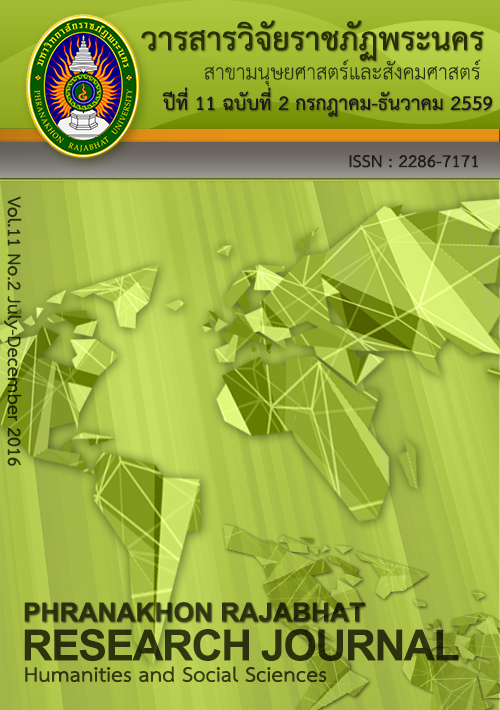การสื่อสารการตลาดแบบแบรนด์คอนเทนต์ในรายการโทรทัศน์เรียลลิตี้โชว์
Main Article Content
Abstract
งานวิจัยนี้มีวัตถุประสงค์เพื่อทราบถึงรูปแบบของการสื่อสารการตลาดแบบแบรนด์คอนเทนต์ใน
รายการโทรทัศน์เรียลลิตี้โชว์ 2 รายการ คือ รายการ STYLISTA และรายการ The Angel นางฟ้าติดปีก
ซีซั ่น 2 และทราบถึงทัศนคติของผู้บริโภคที ่มีต่อตราสินค้าที ่ใช้การสื ่อสารการตลาดแบบแบรนด์คอนเทนต์
โดยอาศัยเทคนิคการสนทนากลุ่ม เลือกผู้เข้าร่วมสนทนากลุ่มแบบเฉพาะเจาะจง จำนวน 30 คน แบ่งเป็น 4
กลุ่ม กลุ่มแรกรับชมรายการ STYLISTA หรือรายการ The Angel นางฟ้าติดปีก ซีซั่น 2 อายุ 20 – 25 ปี
กลุ่มที่สองไม่รับชมรายการ STYLISTA และรายการ The Angel นางฟ้าติดปีก ซีซั่น 2 อายุ 20 – 25 ปี
กลุ่มที่สามรับชมรายการ STYLISTA หรือรายการ The Angel นางฟ้าติดปีก ซีซั่น 2 อายุ 26 – 30 ปี และ
กลุ่มที่สี่ ไม่รับชมรายการ STYLISTA และรายการ The Angel นางฟ้าติดปีก ซีซั่น 2 อายุ 26 – 30 ปี
ผลการวิจัยพบว่า รูปแบบการสื ่อสารการตลาดแบบแบรนด์คอนเทนต์ในรายการ STYLISTA ประกอบด้วย
การสื่อสารตราสินค้าแฝงที่มีความหมายและเข้ากันได้ดีกับเนื้อหารายการและมีการสื่อสารคุณลักษณะ
ตราสินค้าที ่ชัดเจน และรูปแบบการสื ่อสารการตลาดแบบแบรนด์คอนเทนต์ในรายการ The Angel นางฟ้า
ติดปีก ซีซั่น 2 ประกอบด้วยการสื่อสารตราสินค้าแฝงที่สังเกตเห็นได้ชัดเจนและมีการสื่อสารคุณลักษณะ
ตราสินค้าที่คลุมเครือ นอกจากนี้ กลุ่มรับชมรายการมีทัศนคติต่อตราสินค้าที่ใช้การสื่อสารการตลาดแบบ
แบรนด์คอนเทนต์ในระดับดี สามารถรับรู้คุณลักษณะของตราสินค้าจากรายการได้เป็นอย่างดี และสามารถ
จดจำตราสินค้าได้จากรายการ ส่งผลให้อาจเกิดความตั้งใจซื้อ ในขณะที่กลุ่มไม่รับชมรายการ มีทัศนคติ
ที่ดีต่อตราสินค้าเช่นเดียวกัน แต่ไม่เกิดความตั้งใจซื้อตราสินค้า
This research had two objectives: (1) to identify factors of branded content in two
reality television programs, namely, “STYLISTA” and “The Angel Season 2”, and (2) to
identify consumers’ attitudes to brands. The research employed a focus group discussion
with 30 people, who were divided into four groups. The first group involved with people
who had watched “STYLISTA” or “The Angel”, aged 20 – 25 years old. The second group
involved with people who never watched “STYLISTA” and “The Angel”, aged 20 – 25 years
old. The third group involved with people who had watched “STYLISTA” or “The Angel”,
aged 26 – 30 years old. And, the forth group involved with people who never watched
“STYLISTA” and “The Angel”, aged 26 – 30 years old. The study found that (1) factors of
branded content in “STYLISTA” included brand communications were meaningful, there
was a connection with the plot, and brand characteristics were easily identifiable. And
factors of branded content in “The Angel Season 2”included brand communications
were visible and brand characteristics were ambiguous. And (2) people who had watched
branded content reality television programs had positive attitudes towards brands that
used branded content marketing communications, could perceive brand characteristics
from reality television program, and could recognize brands from reality television program
that influenced purchase intention. People who had never watched branded content
reality television programs had positive attitudes towards brands but no intention to buy
Article Details
Each publish articles were copyright by Phranakorn Rajabhat University
Any contents which appeared in each articles in the journal were authors personal opinion. It did not relate to Phranakorn Rajabhat University and other instructors in the university. Each authors would take responsibility on their articles. If there are any mistake, the authors will take responsibility themselves


